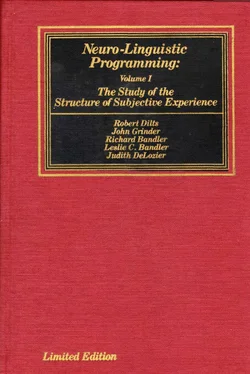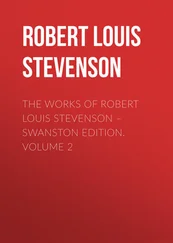3.1 Eliciting the Strategy
Many strategies will spontaneously and naturally appear during the course of a conversation or interaction; that is, people do what they are talking about. As a person talks to you about a problem, the outcome s/he desires, or any other aspect of experience, s/he will explicitly demonstrate, verbally and nonverbally, the strategies ordinarily used to access and make sense of that experience. By being attentive and observant the programmer can reduce much of his or her work and effort in the elicitation process. As people talk about past decisions, they re–run through their strategy steps for making those decisions, like the "instant replays" frequently shown on television sports programs. When an individual talks to you about a stressful experience s/he will cycle through the sequence of representations that lead to the stressful response. A person talking about his or her difficulty in learning will demonstrate to you the very sequence of representations that is giving them the problem.
Typically, however, the particular strategy that you wish to modify or to utilize as a resource is not immediately available to the individual. In such cases the programmer will need to draw upon his or her own resources to elicit the individual's strategy. There are a number of effective ways of doing this.
a) One way to elicit a strategy is to physically place the person in the situation in which the strategy naturally occurs — to work "on location" or "at the scene of the crime," so to speak. The context in which the strategy was developed contains many natural anchors or triggers for that strategy. This kind of elicitation would include options like putting the psychiatric patient back with his family, the pianist at her piano, the mechanic in his shop, the artist in her studio, and so on. You can also gather much useful information with this method about the context, the environment in which the strategy occurs — you will be seeing, hearing and feeling the strategy in action. In some cases, however, this procedure may be inconvenient, costly or impossible to carry out.
b) Presenting, imitating or reproducing a portion of the context in which the strategy takes place will help elicit it. You might choose to mimic the tonality and gestures of the employer, for example, that your client is having difficulty communicating with, or of the sister with whom the client enjoys communicating (depending on the purpose for which you are eliciting the strategy). In The Structure of Magic II we presented an example in which a young mother came to us for help with a severe and uncontrollable habit of child beating. One of the authors elicited her strategy for child beating by mimicking that portion of her child's behavior which triggered the strategy. Once made explicit, the strategy was modified and the woman's problem was solved. Playacting and role playing are other effective means of eliciting strategies using this general approach.
c) By having an individual exaggerate some small portion of the strategy available to them, you will assist that person in accessing the rest of the strategy through the process of transderivational search. We have discussed the transderivational search in detail in Patterns I and II. It is essentially the process of going back across representations from someone's personal history, representations that contributed to the development of some pattern in the person's ongoing behavior. It may usefully be thought of as an age regression to some experience or series of experiences in our personal history that we wish to recover and apply to our ongoing experience to help us modify, cope with or make sense of it. Using our 4–tuple description of experience, we can illustrate the process in the following way:
n, V n, K 1, O n> - Ongoing experience
…..
…..
…..
3, V 3, K 1, O 3> - Age 15
2, V 2, K 1, O 2> - Age 81, V 1, K 1, O 1> - Age 3 Initial experience establishing pattern of behavior.
Here, each 4–tuple is a full representation of some related experience from the client's personal history. In each case something in the context has accessed the same kinesthetic component (Ki) that was originally experienced in the 4–tuple established when the client was three years old. This kinesthetic component serves as the thread which ties all of the experiences together. As the individual exaggerates the kinesthetic component, increasing its relative intensity value, he or she will begin to trigger or anchor up the other components of the 4–tuple representations from the past, increasing their signals in the ongoing situation. For example, a client who was bothered by constant feelings of intense jealousy was assisted through the authors' use of transderivational search to go back in time and to recover full 4–tuple experiences in which he had had that same "jealous feeling." The search stopped when the client was able to describe an incident that happened when he was three years old, an incident in which he recalled screaming and crying because he did not want his mother and father to leave him with a baby sitter. With the initial triggering experience (K i) elicited, his strategy for becoming "jealous" was modified and he experienced no further problems. Any of the representational systems can provide the thread that links a number of 4–tuples together.
Similarly, exaggerating one step in a strategy will serve to access into the present time/space other representations that are linked to it synesthetically. In the example presented in the previous paragraph, the kinesthetic component (K i) was a key step in the client's jealousy strategy, and by asking him to exaggerate it, the authors initiated a transderivational search to experiences in his personal history where the strategy was employed before. As these experiences surfaced more and more, the other steps in the strategy began to surface and to become incorporated into his ongoing experience.
The process of transderivational search is, of course, constantly operating in the ongoing experience of all people. We continually apply representations from our personal history to help us make sense of and deal with our present time/space experience. It is one of the basic methods for learning and understanding common to all members of the human species.
d. Perhaps the most frequently used approach in eliciting a person's strategy for a particular behavior is to ask him or her direct questions about that behavior. The questions we ask will trigger representations and strategies from the individual's personal history.
For instance, if you want to elicit a person's motivation strategy, ask, "Has there ever been a time when you were really motivated to do something?" or "When was the last time you were really motivated?" Similarly, if you wish to elicit someone's creative strategy, simply ask, "What is it like when you are exceptionally creative?" or "Have you ever been in a situation where you were very creative?" As people answer these questions they will access, through transderivational search, the steps of the strategy in question.
Thus, to access someone's strategy for the behavioral outcome "X", you would simply ask questions such as:
"Can you tell me about a time when you were able to X?"
"What is it like to X?"
"Can you X?"
"How do you X?"
"Have you ever X?"
"When were you best able to X?"
"How would you know if you could X?"
"What do you need to do to X?"
"What happens as you X?"
"When was the last time you X?"
If you want to elicit a strategy to serve as a resource to help someone develop more choices about a particular behavioral difficulty, you may also want to ask questions like, "Has there ever been a time when you didn't X?" Then, find out what was different about their strategies and experience at that time as compared to the person's ongoing experience. Referring to the three–point process we presented earlier
Читать дальше











